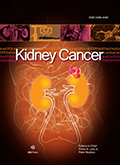Authors: Dibble, Elizabeth H. | Kravets, Sasha | Cheng, SuChun | Sakellis, Christopher | Gray, Kathryn P. | Abbott, Amanda | Bossé, Dominick | Pomerantz, Mark M. | McGregor, Bradley A. | Harshman, Lauren C. | Michaelson, M. Dror | McKay, Rana R. | Choueiri, Toni K. | Krajewski, Katherine M. | Jacene, Heather A.
Article Type:
Research Article
Abstract:
Objective: Compare FDG-PET/CT, CT, and bone scan for detecting and monitoring bone metastases’ response in metastatic renal cell cancer (mRCC). Methods: Patients with mRCC prospectively underwent FDG-PET/CT, CT, and bone scans at baseline and after 8 weeks of therapy. Tumor visibility and metabolic activity were retrospectively recorded. Response was evaluated by PERCIST, RECIST, and MD Anderson bone criteria. Kaplan-Meier methodology estimated event-time distributions for PFS, OS, and time to symptomatic skeletal event (SSE). Log-rank test tested differences in event-time distributions between response at 8 weeks by response criteria. Results: Sixteen patients (n = 30; 53%) were evaluable.
…Baseline FDG-PET/CT detected more osseous metastases (n = 55) than CT (n = 45) or bone scan (n = 34). From baseline to 8 weeks, metabolic activity of lesions decreased >20%, while qualitative and quantitative CT and bone scan parameters were unchanged for most patients. Partial metabolic responders by PERCIST had longer PFS and OS (n = 5, 20+ months) versus those with stable (n = 9; PFS = 9.2 mos, OS = 8.7 mos) and progressive (n = 2; PFS = 5.4 mos, OS = 12.1 mos) metabolic disease, p = 0.09 and 0.42, respectively. By RECIST, longer PFS and OS was seen for stable (n = 12, PFS = 8.3 mos, OS = 17.7 mos) versus progressive (n = 4; PFS = 3.7 mos, OS = 7.5 mos) disease, p = 0.16, 0.02, respectively. OS was not reached, but estimated ≥20 mos, for 4 patients with RECIST SD and PERCIST PMR, compared to OS of 17.7 mos for other patients with RECIST SD. Conclusions: FDG-PET/CT identified more bone metastases and greater numbers of quantitative and qualitative treatment responses in mRCC compared to CT and bone scan. FDG-PET/CT also may identify a sub-group of patients with better outcomes than predicted by standard imaging modalities.
Show more
Keywords: FDG-PET/CT, osseous metastases, renal cell carcinoma, Radium-223, VEGF targeted therapy
DOI: 10.3233/KCA-190075
Citation: Kidney Cancer,
vol. 3, no. 4, pp. 241-251, 2019





